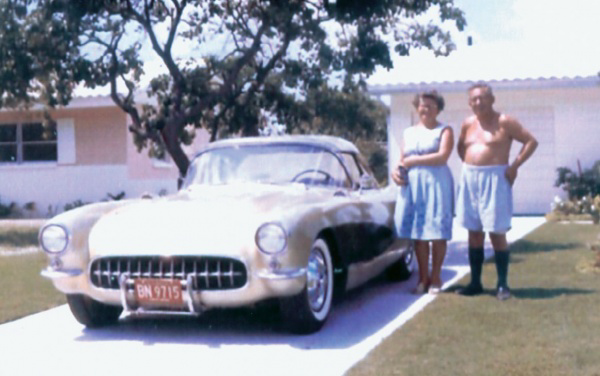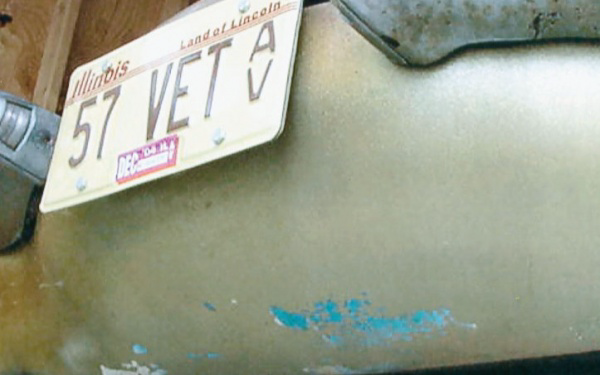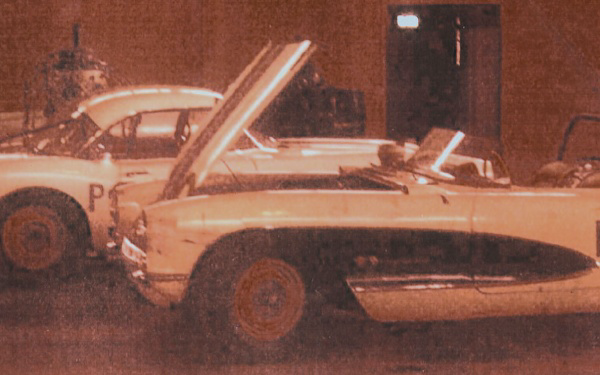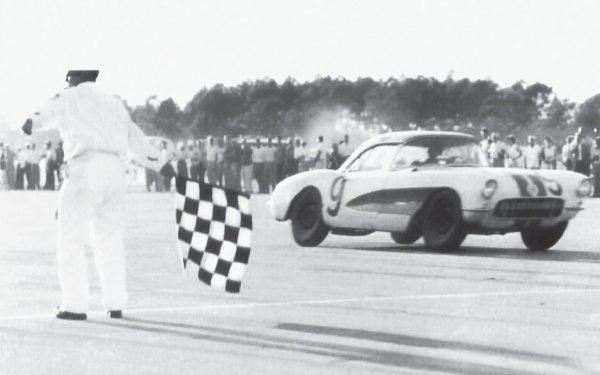A Nose For Rare Vettes

Some people have a knack for sniffing out certain makes of cars. For Joe Trybulec, it’s Corvettes. He has found some rare ones and today we have the tales about two of his best discoveries. These stories originally appeared in The Hemi in the Barn, but are offered online here exclusively. So, enjoy and be sure to subscribe to our mailing list for a chance to win a copy of the book.
Joe Trybulec really likes unusual Corvettes. The retired Wal-Mart executive has owned many of the iconic sports cars and rattles off the story of one that he’s particularly proud of. He was reading a copy of Hemmings Motor News in 2000, when a particular ad caught his eye: “1954 Corvette, 15,000 miles, one owner, fuel-injected V-8 engine.”
“Nobody paid attention to the ad because it was listed with fuel injection,” said Trybulec of Batesville, Arkansas. He said that the normally desirable six-cylinder car was overlooked by Corvette collectors because they imagined it was some cobbled-up hot rod. According to Trybulec’s research, nothing could have been further from the truth.
Back in 1957, Eb Rose became a factory sports car driver for Chevrolet, hired by then General Motors President Ed Cole. This came about because Rose’s father owned Rose Trucking in Houston, and his father had just purchased one hundred new Chevrolet trucks for his business. To show his appreciation to the family, Cole flew down to Texas to eat dinner at the Rose family ranch, which ironically was next to the racing Foyt family’s ranch. During dinner, Cole discovered that the younger Rose was tearing up the sprint car circuit in Texas and offered him a driving contract on the spot.
Not long afterward, Cole received word from the Automobile Manufacturer’s Association (AMA) that GM, as well as all other U.S. car makers, were required to cease racing activities, disband the teams, and sell the cars and equipment immediately.
Up to that point, Chevrolet’s racing program had been managed by an Atlanta-based division called the Southern Engineering and Development Corporation (SEDCO). It provided Chevy with many of the same services that Peter DePaolo, and later Holman-Moody, gave Ford.
When the order came to sell the cars, drivers and teams who had been loyal to Chevy had the first opportunity to purchase the equipment. Eb Rose made out like a bandit.
Rose, who had been a factory sports car driver for GM for only a short time, purchased one of the Bill Mitchell SRII race cars and two production-bodied 1957 Corvettes—which had actually raced at Sebring—for the grand total of three dollars. These Vettes had state of- the-art Black Widow fuel-injected 283 engines built for Sebring, experimental four-speed T10 gearboxes and 4.11:1 rear ends.
Soon thereafter, while racing one of the stock-bodied ’57s in Louisiana, Rose crashed and was terribly hurt. The wrecked race car was shipped back to Houston and put in storage at Rose’s ranch.
Eventually Eb Rose’s friend, George Moore—who owned a three-year-old 1954 Corvette—asked if he could have some of the old parts from the wrecked race car. “Sure,” Rose said. “I only paid a dollar for it.”
So Moore transplanted the Sebring racing drivetrain into his six-cylinder 1954, and for a little while must have had the fastest 1954 Corvette on the planet. Soon thereafter, though, George Moore’s son took the car to work one day at Shell Oil Company, got into an accident, and damaged the car.
The car was brought back to the Moore’s garage, where it sat for the next thirty years.
Trybulec purchased the car out of the Hemmings ad, and found he was the only interested party. He suspected the car’s drivetrain had an interesting history, and when he called his friend Ken Kayser, an engineer who had worked at the Totowanda engine plant for thirty-five years, he was able to positively identify the drivetrain throughout components as having had Sebring heritage.
“The ’54 sits in my garage with fifteen thousand miles on it, untouched from the day I purchased it,” Trybulec said. He is clearly proud of his time capsule.
But the ’54 Corvette is not the car he is most excited about.
Trybulec gets downright giddy when he discusses his really rare find…

One day, Trybulec’s retired engineer friend Ken Kayser called. “A car has surfaced in Chicago,” he said. “I’ve been asked to identify it. The owner had a major stroke and his son and daughter need to sell the house and the cars. There is a Corvette in the garage that hasn’t moved in forty-six years.”
What Kayser discovered was even more amazing than the 1954 Corvette.
The car’s owner, Erwin Rohrer, had been an engineer for Rockwell. He was also a friend of renowned GM designer Harley Earl, as well as GM President Ed Cole.
He also loved racing.
One day Cole gave his friend Rohrer a call and some advice. “Listen, we’re selling the race cars,” Cole said. “Go and buy one of them.”
Rohrer bought a 1957 Corvette on May 10, 1958. It was definitely a used race car—with the roll bar still installed—but it was theoretically new because it had never been sold or titled to anyone besides Chevrolet.
“At the minimum, I knew it was a one-owner fuelie car,” Trybulec said. “So I told Rohrer’s son, Erik, who lives in Colorado, that I’d like to see the car. He couldn’t make it to Chicago on such short notice, but he arranged for me to meet his brother-in-law at the father’s house.

“When we opened the garage door, I discovered a gold-colored Corvette. But upon closer examination, I could see the white-and blue- striped paint job underneath where the paint had begun the flake off from age.”

Kayser helped Trybulec identify the car. They were looking at the missing Sebring car—the one that had eluded and confused collectors for forty-six years.
“The brother-in-law asked if I wanted to go into the basement to see some of the documentation they also had,” Trybulec said. “In that stack of paperwork, I discovered this very car had been used for initial four-speed testing.”
“I really want to buy this car,” he told the brother-in-law. “Well, you’d better talk to Erik in Colorado,” he said.
While Trybulec was rummaging through the basement of Rohrer’s house, he found a number of items typical of a man the age of the Corvette’s owner: an Army uniform from the Korean War, old cameras, and pictures, but then something really caught his attention.
“On the floor, I saw wooden Indian plaque,” Trybulec said. “It was exactly the same wood shop project I had done in high school. It turns out that Mr. Rohrer and I went to the same school, the Albert G. Lane Technical High School in Chicago, although I went there twenty years later.”
Trybulec waxed nostalgic about his old alma mater. “We had six thousand boys in our school. It was based on a thirty-four-acre campus and had two metal foundries, two metal shops, two wood shops, and a terrific sports program.”
Trybulec hoped he could spin this happy coincidence to his favor. “I called Erik and told him I’d like to buy the Corvette; that it was a very important car,” he said. “But I told him at the very least I’d like to have the Indian plaque. It connected me with his dad, and ironically, his mother was from Arkansas, where I now lived.”
Trybulec accomplished what so many barn finders are unable to do: establish a relationship on some other level, about some other topic.
“He told me I could make an offer, but that he already had two other offers,” he said.
Trybulec made Erik a significant cash offer, which he knew would be higher than either of the other two offers he had received so far.
“I’ll have to talk it over with my sister,” Erik said, even though it was clear that Mr. Rohrer had left the car specifically to his son.
“I also need to tell the other two bidders,” Erik said. “I told him I didn’t want to get into a bidding war,” Trybulec said.
Not surprisingly, Erik called Trybulec back after he told the other two bidders of Trybulec’s significant cash offer. They both countered with offers $10,000 higher.
“So I thought for a minute,” Trybulec said. “Then I offered him my final deal. I said that I would make him a one-time cash offer, and if he accepted it, the car was mine. I told him I could come to Chicago next week to pick it up.”
The following week, as Trybulec was driving up to Chicago to pick up “his” car, Erik called him. “He said ‘I felt the honorable thing to do was to let the other two bidders know of your offer,’” Trybulec said. “My heart stopped beating.”
One of the other bidders, who had been intent on owning the Corvette, apparently started becoming very aggressive with Erik. “What are you, stupid?” said the other bidder. “That’s the missing Nassau/Sebring car!”
Erik said, “I don’t know you, but I don’t like you. The car is Joe’s [Trybulec]!”
When he got to Chicago and met Erik, Trybulec found out more about the car and about the relationship between Erik and his father. When Erik was a child, his father had always told him to stay away from the car. Erik hated the car and couldn’t wait to get rid of it.
Trybulec couldn’t help but believe that the lucky coincidence of the high school had helped him acquire the car. Trybulec loaded up the car and trailered it home.
The promoters at the Bloomington Gold Corvette show wanted him to display his newly found car in as-found condition. “That made me nervous,” he said. “I had been to Bloomington at least twenty-five times, and all the cars were mega-bucks restorations.”
But Trybulec’s unrestored barn find was one of the most popular cars in the show.
Then he got a call from GM’s racing manager, who said they were interested in helping him identify the car and its components. The manager also offered to help me with anything I needed.
“I told him I wanted photos of the car,” Trybulec said. “He said they would search through GM’s archives and get back to me.”

When GM got back to him, he couldn’t have been more pleased. His car had set the world speed record for its class at Daytona Beach and had finished first-in-class, fourth overall, at the New Smyrna Beach road race when Paul Goldsmith drove it to finish behind Carroll Shelby, Lance Reventlow, and one of the Holman-Moody Thunderbirds. At first the GM archive search turned up sixteen photographs, but ultimately more than six hundred photos were turned over to Trybulec. They were mostly of his car, but also of other period Corvette race cars. He also received six vintage videos of his Corvette racing.
Suddenly, his phone was ringing off the hook with calls of congratulations and offers to buy.
But it’s not for sale.
“I’m inclined to leave the car the way it is and not restore it,” he said. “Not that I don’t appreciate restored cars, but this one hasn’t been driven since 1967 and is one hundred percent authentic.”
The only thing he might one day consider is to remove the gold paint. “The white with blue paint under the gold is perfect,” he said. “If I could remove the gold without damaging the original paint, I might try it.”
And, quite possibly, his good fortune in owning the car is because of a lucky wooden Indian plaque.
Lucky indeed.
Auctions Ending Soon
 2006 Ford Mustang Saleen S281 SCBid Now1 days$15,000
2006 Ford Mustang Saleen S281 SCBid Now1 days$15,000
 2002 Subaru Impreza WRXBid Now4 days$100
2002 Subaru Impreza WRXBid Now4 days$100
 1975 Chevrolet Corvette ConvertibleBid Now4 days$3,000
1975 Chevrolet Corvette ConvertibleBid Now4 days$3,000
 1964 Ford F-100 Camper CustomBid Now4 days$500
1964 Ford F-100 Camper CustomBid Now4 days$500
 2006 Jeep Wrangler SportBid Now6 days$4,000
2006 Jeep Wrangler SportBid Now6 days$4,000

Comments
Developing a nose for finding certain kinds of cars lies mainly in being devoted to them. Back in the ’70s I owned a Packard, was a member in both the local & national Packard clubs and collected darned near ANYTHING to do with Packards. Between that and the fact Packards were still viewed as unwanted orphan cars, I found Packards on a regular basis. I’d buy them very cheaply, get them running and turn them over, usually to members of the local club. Nothing nearly as glamorous as finding a long lost factory racer, but I felt good with each car I sold to a happy collector as that was another one saved from the crusher!
“each car I sold to a happy collector…was another one saved from the crusher”
Great stories—both the Corvette and the Packard!
Great story for knowledge and perseverance.
another great story. glad it worked out and the car went to a good home. and what is the story on the ford truck in the background of the first photo?
What Fantastic Finds! I have also found some rare corvettes (Baldwin Motion/Motion Performance Stuff) and it amazes me when people are encountered with it and say stupid stuff like “if only it was stock” I had a 1968 427/435 coupe I purchased that was delivered with L88 flares behind the front seats! (documented), broke my heart to sell that car and The Moray GT, but we needed the $$$ for a business project. I also had a chance to purchase a 1954 corvette with a complete 1957 283/283 FI motor installed and a 4 speed, a local guy had built the car (Rochester Products, maker of the FI units is/was in our town of Rochester NY) and he aquired much of what he needed right from work. Documentation is key, but keep looking, there is stuff still out their and alot of times the “experts” don’t know what they are looking at…….
Yeah, nothing like seeing something the “experts” say doesn’t exist. Other bidder’s rudeness shows perfectly why sometimes the money isn’t everything a seller considers:)
In the 50’s and 60’s Rochester NY was a hotbed for sports cars and built street rods. Rochester Institute of Technology and the GM Institute had a lot of young car guy engineer types inside Rochester Products and the Delco Division as interns. Fuel injection was exotic as only Mercedes Benz with the 300SL had it in production cars. But once the interns and serious car guys at Rochester Products could get their hands on one, they startied showing up everywhere, like with the Raymond Brothers dragster. On the street, you were king with a fuelie ‘vette, but guys were retrofitting F.I. into ’57 Chevys. I’ve even heard of a Pontiac with a F.I. unit. Building hot rods back then, you didn’t use a blower, it was a built small block with FI. Rochester was a GM-“BowTie” city, no doubt about it. Mt. Read Blvd. outside Rochester Products had lots of black tire marks on the pavement. If you knew where to look, there were lots of garages with the lights on late at night. Even the Gannett Times Union sponsored Soap Box Derby had a huge entry list and a national winner. Great time to be a car guy.
I had a ’54 Corvette in the late 60’s, which was a daily driver (in the summer), and I wish I had thought of a putting a 283 and 4 speed in it, which I could have done in 1969, and it would have been a “B” car, rather than a “C”. (It always started, carbs always leaked gas, it was very nose heavy, went straight well, with that heavy long six, but was not interested in going around a corner, and that Powerglide 2 speed automatic was pretty slushy – engine would go and car would catch up.) In additon if you were over 5’8″ tall, there was not enough head room unless the top was down. And it had plexiglass side curtins. So still not an “A”.
Er,
was the original colour of that Vette white & black or gold & black as in the picture with it trailered?
Andrew
Twickenham, England